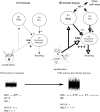Breathing at high altitude
- PMID: 19756384
- PMCID: PMC11115747
- DOI: 10.1007/s00018-009-0143-y
Breathing at high altitude
Abstract
Acclimatization to long-term hypoxia takes place at high altitude and allows gradual improvement of the ability to tolerate the hypoxic environment. An important component of this process is the hypoxic ventilatory acclimatization (HVA) that develops over several days. HVA reveals profound cellular and neurochemical re-organization occurring both in the peripheral chemoreceptors and in the central nervous system (in brainstem respiratory groups). These changes lead to an enhanced activity of peripheral chemoreceptor and re-inforce the central translation of peripheral inputs to efficient respiratory motor activity under the steady low O(2) pressure. We will review the cellular processes underlying these changes with a particular emphasis on changes of neurotransmitter function and ion channel properties in peripheral chemoreceptors, and present evidence that low O(2) level acts directly on brainstem nuclei to induce cellular changes contributing to maintain a high tonic respiratory drive under chronic hypoxia.
Figures

Similar articles
-
Role of chemoreception in cardiorespiratory acclimatization to, and deacclimatization from, hypoxia.J Appl Physiol (1985). 2014 Apr 1;116(7):858-66. doi: 10.1152/japplphysiol.01126.2013. Epub 2013 Dec 26. J Appl Physiol (1985). 2014. PMID: 24371017 Free PMC article. Review.
-
Altered structure and function of the carotid body at high altitude and associated chemoreflexes.High Alt Med Biol. 2000 Spring;1(1):63-74. doi: 10.1089/152702900320694. High Alt Med Biol. 2000. PMID: 11258588 Review.
-
Ibuprofen Blunts Ventilatory Acclimatization to Sustained Hypoxia in Humans.PLoS One. 2016 Jan 4;11(1):e0146087. doi: 10.1371/journal.pone.0146087. eCollection 2016. PLoS One. 2016. PMID: 26726885 Free PMC article. Clinical Trial.
-
The role of arterial chemoreceptors in ventilatory acclimatization to hypoxia.Adv Exp Med Biol. 1994;360:109-22. doi: 10.1007/978-1-4615-2572-1_10. Adv Exp Med Biol. 1994. PMID: 7872069 Review. No abstract available.
-
What Is the Point of the Peak? Assessing Steady-State Respiratory Chemoreflex Drive in High Altitude Field Studies.Adv Exp Med Biol. 2018;1071:13-23. doi: 10.1007/978-3-319-91137-3_2. Adv Exp Med Biol. 2018. PMID: 30357729
Cited by
-
Hypoxia switches episodic breathing to singlet breathing in red-eared slider turtles (Trachemys scripta) via a tropisetron-sensitive mechanism.Respir Physiol Neurobiol. 2015 Feb 1;207:48-57. doi: 10.1016/j.resp.2014.12.015. Epub 2014 Dec 24. Respir Physiol Neurobiol. 2015. PMID: 25543027 Free PMC article.
-
Carotid Body and Metabolic Syndrome: Mechanisms and Potential Therapeutic Targets.Int J Mol Sci. 2020 Jul 20;21(14):5117. doi: 10.3390/ijms21145117. Int J Mol Sci. 2020. PMID: 32698380 Free PMC article. Review.
-
Correlates of obesity-related chronic ventilatory failure.BMJ Open Respir Res. 2016 Feb 18;3(1):e000110. doi: 10.1136/bmjresp-2015-000110. eCollection 2016. BMJ Open Respir Res. 2016. PMID: 26918192 Free PMC article.
-
Are cardiorespiratory complications a question of epigenetics?Proc Natl Acad Sci U S A. 2012 Feb 14;109(7):2192-3. doi: 10.1073/pnas.1121364109. Epub 2012 Feb 2. Proc Natl Acad Sci U S A. 2012. PMID: 22308480 Free PMC article. No abstract available.
-
Is altitude a determinant of the health benefits of nature exposure? A systematic review and meta-analysis.Front Public Health. 2022 Nov 25;10:1021618. doi: 10.3389/fpubh.2022.1021618. eCollection 2022. Front Public Health. 2022. PMID: 36504926 Free PMC article.
References
-
- Weil JV. Control of ventilation in chronic hypoxia: role of peripheral chemoreceptors. In: Lahiri S, Cherniak NS, Fitzgerald RS, editors. Response and adaptation to hypoxia: organ to organelle. New York: Oxford University Press; 1991. pp. 122–132.
-
- Smith C, Bisgard G, Nielsen A, Daristotle L, Kressin N, Forster H, Dempsey J. Carotid bodies are requiered for ventilatory acclimatization to chronic hypoxia. J Appl Physiol. 1986;60:1003–1010. - PubMed
-
- Busch MA, Bisgard GE, Forster HV. Ventilatory acclimatization to hypoxia is not dependant on arterial hypoxemia. J Appl Physiol. 1985;58:1874–1880. - PubMed
-
- Schoene RB, Lahiri S, Hackett PH, Peters RM, Jr, Milledge JS, Pizzo CJ, Sarnquist FH, Boyer SJ, Graber DJ, Maret KH, West JB. Relationship of hypoxic ventilatory response to exercise performance on Mount Everest. J Appl Physiol. 1984;56:1478–1483. - PubMed
-
- León-Velarde F, Arregui A, Monge C, Ruiz Y, Ruiz H. Aging at high altitudes and the risk of Chronic Mountain Sickness. J Wild Med. 1993;4:183–188.
Publication types
MeSH terms
LinkOut - more resources
Full Text Sources

